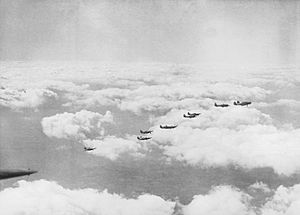John Latta (RAF officer) facts for kids
Quick facts for kids
John Blandford Latta
|
|
|---|---|
| Born | 6 August 1914 Vancouver, British Columbia, Canada |
| Died | 12 January 1941 (aged 26) English Channel |
| Allegiance | Canada |
| Service/ |
Royal Air Force |
| Rank | Flying Officer |
| Unit | No. 242 Squadron |
| Battles/wars | Second World War
|
| Awards | Distinguished Flying Cross |
John Blandford Latta, DFC (born August 6, 1914 – died January 12, 1941) was a brave pilot from Canada. He joined the Royal Air Force (RAF) during the Second World War. He was known for shooting down at least seven enemy planes.
John Latta was born in Vancouver, Canada. He joined the RAF in early 1939. After his training, he became part of No. 242 Squadron. He flew a Hawker Hurricane fighter plane. He flew many missions during the Battle of France. He also helped protect soldiers during the Dunkirk evacuation. Later, he fought in the Battle of Britain. He earned the Distinguished Flying Cross for his courage. Sadly, he died in January 1941 during a flight to France.
Contents
Early Life and Joining the RAF
John Blandford Latta was born in Vancouver, British Columbia, Canada, on August 6, 1914. His father, William S. Latta, was a soldier in the First World War. John went to Oak Bay High School and then Victoria College.
After college, he worked as a salmon fisherman. He even had his own fishing boat. From 1930 to 1933, he also served in the army reserves. He was part of the 16th Canadian Scottish Territorial Regiment. This was the same unit his father had been in.
John saw an advertisement asking for new pilots for the Royal Air Force (RAF). He applied and was accepted as a pilot trainee. In early 1939, he traveled to the United Kingdom. He began his flight training in March. He earned his pilot's "wings" (a badge showing he was a qualified pilot) the next month. Then, he continued his advanced training.
Fighting in the Second World War
In November 1939, the Second World War had already begun. John Latta was sent to No. 242 Squadron. This squadron was based at Church Fenton. It was made up of Canadian pilots. At first, the squadron used Bristol Blenheim and Fairey Battle planes. But in February 1940, they received Hawker Hurricane fighter planes.
The squadron finished its training by March 23, 1940. This meant they were ready for combat. By this time, John Latta was a full pilot officer.
Battle of France Missions
In May 1940, Germany invaded France. No. 242 Squadron started flying missions from Biggin Hill in England. They flew over France to patrol the battle areas. After one week, the squadron moved to France to be closer to the fighting.
They became very busy helping British soldiers retreat. These soldiers were part of the British Expeditionary Force (BEF). John Latta got his first aerial victory while helping to protect the BEF. Many soldiers were trapped at Dunkirk and needed to be rescued by sea.
On May 29, John shot down a Messerschmitt Bf 109 fighter plane. This happened about 15 miles (24 km) east of the Dunkirk beaches. Two days later, he destroyed another Bf 109 right over Dunkirk. The squadron stayed in France even after the BEF left Dunkirk. They supported the remaining British units as they moved back to Brittany. Their last base in France was at Nantes. From there, the surviving pilots flew back to England. They landed at Coltishall on June 18 to rest and get new equipment.
Battle of Britain Heroics
No. 242 Squadron was ready for action again on July 9. Now, Squadron Leader Douglas Bader was in charge. The very next day, John Latta destroyed a Heinkel He 111 medium bomber east of Lowestoft. In August, the German air force, called the Luftwaffe, attacked more often. The squadron fought many battles north and east of London.
On August 21, John Latta helped destroy a Dornier Do 17 bomber. This happened about 8 miles (13 km) west of Harleston. He wrote to his family that he thought he "hit his [the bomber's] loaded bomb rack." On September 9, he shot down a Bf 109 over the Thames River. Then, on what is now called Battle of Britain Day, he destroyed another Bf 109 over Maidstone. On September 27, he destroyed two more Bf 109s. One crashed into the sea near Dover, and the other crashed inland.
As October arrived, there were fewer air battles. No. 242 Squadron tried flying at night for a while, but it was not very successful. In early November, John Latta was promoted to flying officer. Soon after, he received the Distinguished Flying Cross. This award is given for bravery in air combat.
The official statement about his award said:
Pilot Officer Latta has destroyed eight enemy aircraft in operations over France and this country. On one occasion, his squadron attacked a number of Messerschmitt 109's. This officer destroyed one and, although his own aircraft had been hit in the wings and tail by cannon shells, attacked and destroyed a second enemy aircraft. He has displayed the utmost coolness in the midst of fierce combat.
In early 1941, Fighter Command started flying attacks into France. John Latta was part of the first big mission. On January 10, No. 242 Squadron helped protect bombers attacking an airfield near Calais. Two days later, the squadron flew more quick attacks along the French coast.
John Latta was killed on this day. He and his wingman (another pilot flying with him) were attacked by Bf 109s. His plane was shot down over the English Channel.
John Latta has no known grave. He is remembered at the Runneymeade Memorial in Englefield Green. He is officially credited with destroying seven enemy aircraft. He also helped destroy another one.


